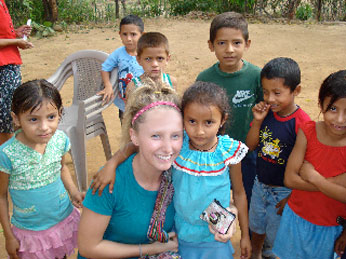
A group of Nicaraguan children surround Courtney Holtz during her recent mission trip. Holz visited areas where the children were terrified of seeing a white person for the first time.
Courtney Holtz, now a junior at the University of San Diego in California, describes her recent semester break as quite an experience. She had traveled with her friend Gabe De Anda on a 17-day mission trip to Nicaragua. They paid their own way accompanying De Anda's great uncle and aunt, Phil and Sue Wheaton who, having lived in Latin America, organized the humanitarian projects in the villages they visited through the auspices of a church in Tacoma Park, MD, adjacent to Washington, D.C.
The university that Courtney attends has a focus on international studies and a mission of fostering cultural diversity and peace and ranks sixth in the nation as a doctorate institution offering undergraduate participation in study abroad.
In a letter to her grandmother Alice Holtz, Courtney reported,"It was interesting. :) It definitely wasn't what I expected, and I don't think that I ever want to go back there, but it was definitely an experience."
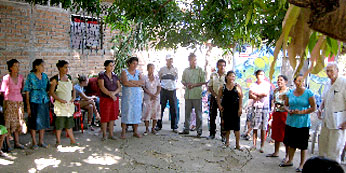
A group of villagers gather with Phil Wheaton, pictured extreme right. Wheaton has been revered for organizing many humanitarian projects in the economically depressed Latin American country of Nicaragua.
This is Courtney's story:
Nicaragua is a very sad, poor, and oppressed country, and I could feel the heaviness just being in the midst of it. I learned a lot about the history of political oppression and the terrible dictator named Somoza. Now, the revolutionaries called the Sandanistas (also known as the FSLN) are in control, but it is still an oppressed country because, once in power, many of the revolutionaries became corrupt as well. As for poverty, Nicaragua is the second poorest nation in the Western Hemisphere behind Haiti.
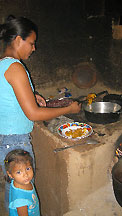
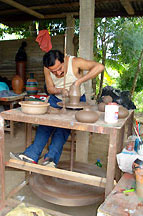
People in the village were self-sufficient. At left, a woman cooks on a clay stove. At right, a potter creates household items.
I didn't sleep much on the trip because I was so scared!! There were spiders as big as my hand (I'm NOT exaggerating), scorpions, fleets of mosquitoes, armies of ants, snakes, and so much more. Augh! I was eaten alive by mosquitoes and ants. We learned not to squish ants. The dead ones would give off a pheromone that would attract more biting ants.
Our accommodations there were also very uncomfortable: like a bed frame for a bed and dirt floors. Showers were dumping buckets of cold water on your head, toilets were holes in the ground...etc. So, it was the most uncomfortable living I've ever experienced, and there were times that I thought I wanted to go home, but I felt so selfish because that WAS home for so many people...so it was very eye-opening for me.
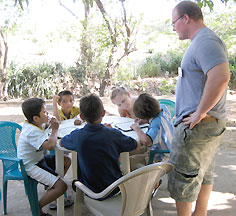
Teaching English to a group of village children involved the use of boards--putting a Spanish word like "tia" on one of them and the English equivalent, "aunt" on the other.
Our main purpose for going was to help in a small village called Jinocuao, outside of Chinedega and Somotillo (Jinocuao is NOT on the map). While we were in the village, Gabe and I team taught a Spanish-English class to the kids and that was so much fun. We had between 15-35 kids each day. We worked so well together and the kids were precious. Other than that, most of our time spent there was in solidarity with the people, just learning and understanding their situations and circumstances and helping them cope, while also learning from them.
It was so amazing to see how much they do with so little and how the village as a community works together. For example, when animals are donated to the village or someone gets some, they give away the first two offspring to other people in the community who then do the same--and therefore spread the wealth throughout the whole community. There were so many other examples of this teamwork that it was truly amazing. We also spent some time at a women's center and multiple hospitality houses.
Another interesting thing, in the village there were many children that had never seen a white person before, so when we got there they started crying! and Gabe is like a giant there so some of the kids were a little scared of him too.
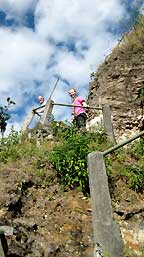
This pathway to the clouds in Nicaragua was a viewpoint near Selva Negra. The area is both jungle and mountainous.
We had a little time to have some fun just traveling around the country. We got to go zip lining though the jungle, go to the beach, see the rain forest, the black jungle, coffee plantations, real chocolate beans, and a lot more cool stuff! So that was fun.
While we were traveling we were stopped by the police multiple times and check searched (one time I didn't have my passport with me--so I could have been arrested or deported, but luckily the cop didn't notice he was missing one since we handed him all the passports at one time!) Also, I always had Gabe with me (personal body guard), but one time I wanted to shop at the vendors right next to the hotel so I told him I would meet him back at the hotel and seriously, the second Gabe was out of sight, I was swarmed by a group of people...people were touching me, trying to take my things, and trying to sell me things and I was like "No me toques" ("Don't touch me!") and ran back to the hotel! Scary!! So I didn't leave Gabe's side for the rest of the trip!
Being Americans down there was a little unnerving, especially hearing about all the gang activities in the area involving slitting American's throats and terrible things like that. Yeah....it was definitely an uncomfortable experience.
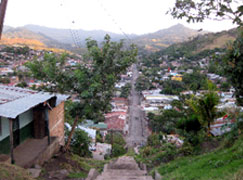 Getting around the villages was somewhat difficult due to a lack of signage.
Getting around the villages was somewhat difficult due to a lack of signage.
Some other notable things...there are no street signs or addresses in Nicaragua! So, as you can imagine, getting around is...difficult to say the least! People just say, "go up to the church and turn left, then go up to the green house and turn right" and stuff like that. Oh and the food was good...LOTS of beans and rice (called gallo pinto), and platanos (look like bananas but they are vegetables and taste like potatoes, I LOVE them), and chicken (that they butchered earlier that morning).
The weather is also notable. Nicaragua is in the tropics. It was nice and warm--between the 80's-90's with humidity; so it was like a wonderful blanket of heat!
In summary, Courtney called her trip "an eye-opener." It definitely was the worst conditions she had ever experienced, but an unforgettable learning experience.






Comments